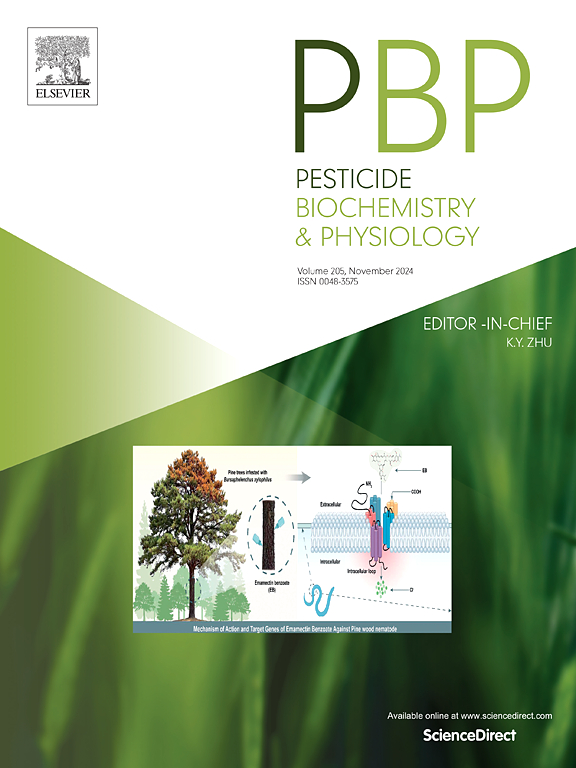短期暴露于伊维菌素对果蝇的影响
IF 4.2
1区 农林科学
Q2 BIOCHEMISTRY & MOLECULAR BIOLOGY
引用次数: 0
摘要
为了研究亚致死浓度的伊维菌素(IVM)对野生型果蝇(Drosophila melanogaster)的影响,建立了一种短期伊维菌素暴露方法。使用传统的玻璃瓶接触方法,选择暴露于IVM(0.01至1000 ppm) 12小时或更短时间,以评估短期IVM暴露(STIEs)对果蝇的下游影响。在这些条件下,所有雌性果蝇在卵巢中产生的活性氧和丙二醛水平均显著提高。此外,在STIE条件下使用IVM治疗12小时的雌性卵巢DNA损伤水平显著增加。尽管存在上述负面影响,但暴露于ivm的雌虫产卵的平均孵化率与未暴露于ivm的雌虫的孵化率相比,没有统计学差异。选择两种浓度(1和10 ppm)的IVM来确定短期IVM暴露后的跨代效应。暴露于IVM的F1、F2和F8果蝇发育明显延迟(分别延迟2.5 ~ 3.2、2.5 ~ 3.0和0.9 ~ 1.3 d)。F5、F11和F17雌性在致死性IVM存在时表现出明显延迟IVM诱导的迟缓行为(1%,w/v)。与未暴露的果蝇相比,跨代暴露于1ppm IVM的F18雌性果蝇表现出显著增加的Mrp1(8.7倍)和Cyp6g2(5.9倍)转录物水平。相比之下,暴露于10 ppm IVM的F18雌性跨代显示Cyp9f2水平显著增加(2.6倍)。目前的研究清楚地证明了亚致死IVM对果蝇亲代和子代的影响,为了解在STIE条件下IVM抗性的发展提供了重要的一步。本文章由计算机程序翻译,如有差异,请以英文原文为准。

Impacts of short-term ivermectin exposures on fruit flies
A short-term ivermectin (IVM) exposure method was newly established to demonstrate effects of sublethal concentrations of IVM on the wild-type fruit fly, Drosophila melanogaster. Using a conventional glass-vial contact approach, exposures to IVM (0.01 to 1000 ppm) for 12 h durations or less were selected to assess the downstream impacts of short-term IVM exposures (STIEs) on fruit flies. Under these conditions, all female flies produced significantly higher levels of reactive oxygen species and malondialdehydes in their ovaries. Additionally, females treated with IVM for 12 h under the STIE conditions exhibited significantly increased levels of DNA damages in their ovaries. Despite the negative impacts described above, the mean percent hatchability values obtained from the eggs oviposited by the IVM-exposed females were not statistically different when compared to the hatchability of the unexposed females. Two concentrations (1 and 10 ppm) of IVM were selected to determine transgenerational effects following short-term IVM exposures. F1, F2 and F8 flies exposed to IVM showed significantly delayed developments (2.5–3.2, 2.5–3.0, and 0.9–1.3 days delayed, respectively). F5, F11 and F17 females showed significantly delayed IVM-induced sluggish behaviors in the presence of lethal IVM (1 %, w/v). F18 females transgenerationally exposed to 1 ppm IVM exhibited significantly increased levels of Mrp1 (8.7-fold) and Cyp6g2 (5.9-fold) transcripts compared to unexposed flies. Comparatively, F18 females transgenerationally exposed to 10 ppm IVM showed significantly increased levels of Cyp9f2 (2.6-fold) transcripts. Current study clearly demonstrated the effects of sublethal IVM on parent and filial generations of fruit flies, providing an important step toward understanding development of IVM resistance under the STIE conditions.
求助全文
通过发布文献求助,成功后即可免费获取论文全文。
去求助
来源期刊
CiteScore
7.00
自引率
8.50%
发文量
238
审稿时长
4.2 months
期刊介绍:
Pesticide Biochemistry and Physiology publishes original scientific articles pertaining to the mode of action of plant protection agents such as insecticides, fungicides, herbicides, and similar compounds, including nonlethal pest control agents, biosynthesis of pheromones, hormones, and plant resistance agents. Manuscripts may include a biochemical, physiological, or molecular study for an understanding of comparative toxicology or selective toxicity of both target and nontarget organisms. Particular interest will be given to studies on the molecular biology of pest control, toxicology, and pesticide resistance.
Research Areas Emphasized Include the Biochemistry and Physiology of:
• Comparative toxicity
• Mode of action
• Pathophysiology
• Plant growth regulators
• Resistance
• Other effects of pesticides on both parasites and hosts.

 求助内容:
求助内容: 应助结果提醒方式:
应助结果提醒方式:


